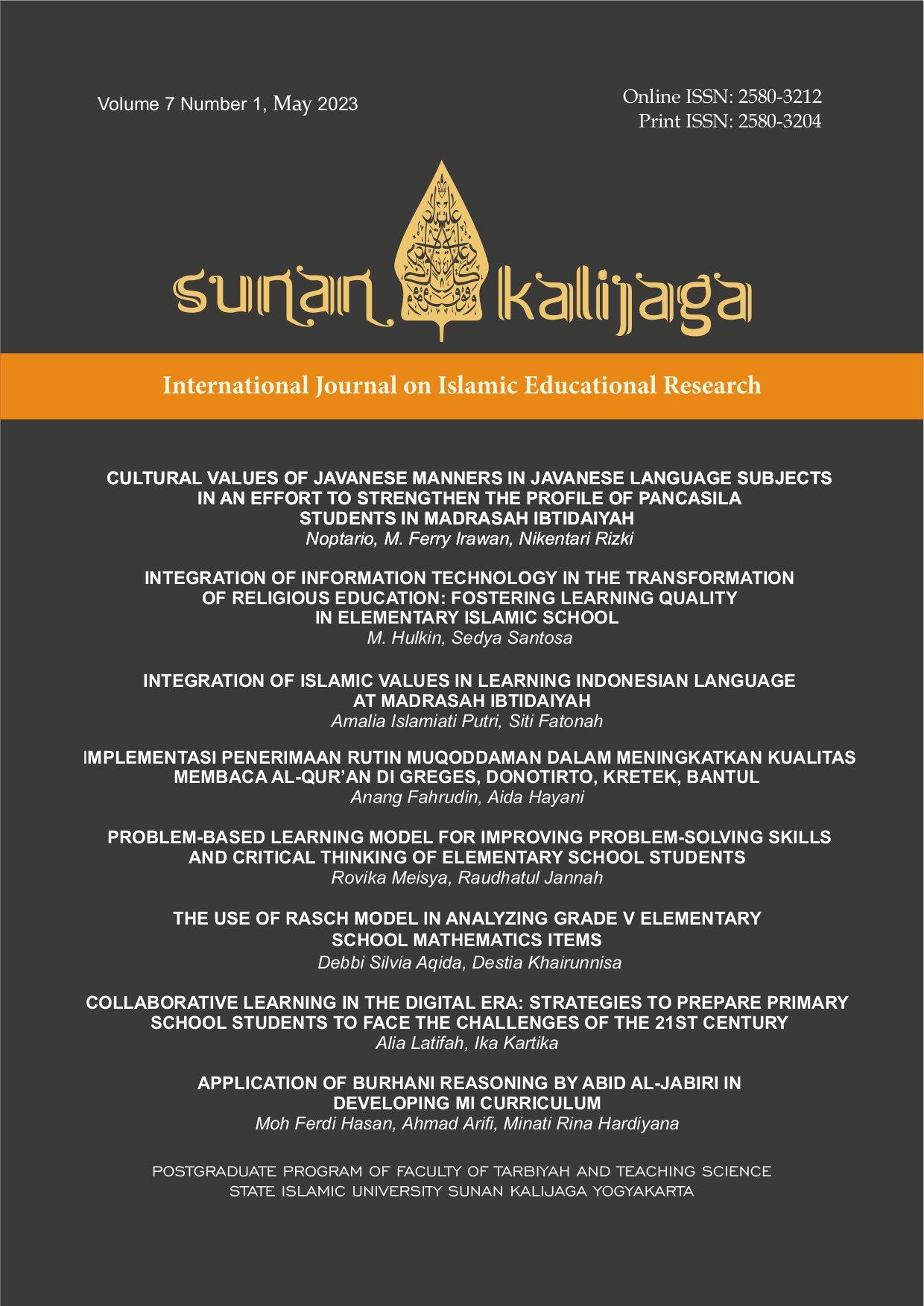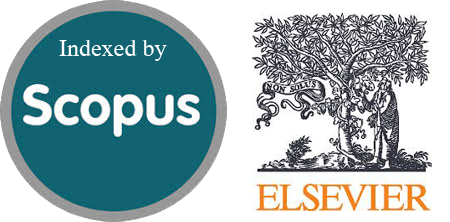Application of Burhani Reasoning by Abid Al-Jabiri in Developing MI Curriculum
DOI:
https://doi.org/10.14421/skijier.2023.71.08Keywords:
Burhani Reasoning, Abid Al-Jabiri, Curriculum Development, Madrasah Ibtidaiyah, Critical and Logical ThinkingAbstract
This research examines the implementation of the concept of Burhani reasoning by Abid al-Jabiri in the curriculum development of Madrasah Ibtidaiyah (MI) School. Through a qualitative approach and case study method, this research explores how Burhani reasoning has been successfully applied by teachers, principals, and students in MI. Data collection techniques through in-depth interviews, participatory observation, and curriculum documentation study. The research results show that Burhani reasoning has been successfully applied in the MI curriculum and the integration of teaching methods based on Burhani reasoning with traditional methods has been successful. This has an impact on increasing students' critical and logical thinking abilities. This study suggests the importance of continuous training for teachers in applying Burhani reasoning in teaching and suggests further research to see the long-term impact of the implementation of Burhani reasoning on student learning outcomes. In conclusion, the application of Burhani reasoning has been proven to improve the quality of education in MI.
Downloads
References
Afwadzi, Benny. “Interaksi Epistemologi Bayani, Burhani, Dan Irfani Dengan Pendidikan Agama Islam: Tawaran Interconnected Entities.” Journal of Education, Madrasah Innovation and Aswaja Studies (MJEMIAS) 2, no. 1 (2023): 28–37. https://jurnal.maarifnumalang.id/.
Amrullah, Muhammad Afif, Alaika Muhammad B.K.P.S, Imam Fawaid, and Moch Ishaq Alfaruq. “Implementasi Bayani, Irfani, Burhani Terhadap Pendidikan Karakter Santri Dalam Sistem Pendidikan Di Pesantren.” El-Buhuth: Borneo Journal of Islamic Studies 5, no. 1 (2022): 55–63. https://doi.org/10.21093/el-buhuth.v5i01.4100.
Arizky, Zefri, Candra Wijaya, and Zaini Dahlan. “Religious Moderation in Students at High School Muhammadiyah” 6, no. 4 (2023): 504–15.
Creswell. Research Design: Qualitative, Quantitative, and Mixed Methods Approaches. 5th ed. Thousand Oaks, CA: Sage Publication, 2014.
Creswell, J. W, and C. N Poth. Qualitative Inquiry and Research Design: Choosing among Five Approaches. 4th ed. Thousand Oaks, CA: Sage Publication, 2017.
Fadhil, Moh, and Muhammad Rosyad Sudrajad. “AHMADIYYA CONGREGATION IN THE SHADOW OF RELIGIOUS POLITICS : TENSIONS BETWEEN LAW AND FREEDOM OF RELIGION” 08, no. 01 (2023): 21–40.
Hadikusuma, Wira. “Epistemologi Bayani, Irfani Dan Burhani Al-Jabiri Dan Relevansinya Bagi Studi Agama Untuk Resolusi Konflik Dan Peacebuilding.” Jurnal Ilmiah Syi’ar 18, no. 1 (2018). https://doi.org/10.29300/syr.v18i1.1510.
Hasan, Moh. Ferdi. “Arsyad Al-Banjari’s Insights on Parallel Reasoning and Dialectic in Law: The Development of Islamic Argumentation Theory in the 18th Century in Southeast Asia.” RJLP 25, no. 0 (2022): 1–250. https://doi.org/10.1007/978-3-030-91676-3_1.
Hasyim, Mochamad. “Epistemologi Islam (Bayani, Burhani, Irfani).” Jurnal Al-Murabbi 3, no. 2 (2018): 217–28. https://doi.org/10.35891/amb.v3i2.1094.
Jaeni, Muhamad, and Moh Nurul Huda. “Ibn Rusyd’s Epistemology and The Future of Islamic Knowledge Development.” Proceeding International Conference on Islam and Education (ICONIE) 1, no. 1 (2021): 715–35.
Li, Lingli, Fuquan Huang, Siyu Chen, Leiqiong Pan, Wenjie Zeng, and Xiaoqi Wu. “Exploring the Curriculum Development in Content and Language Integrated Learning: A Systematic Review.” International Journal of Evaluation and Research in Education 9, no. 4 (2020): 1102–13. https://doi.org/10.11591/ijere.v9i4.20705.
Maso’od, Mashitah, Asif Khushaini, Rohana Ahmad, Nor’Aini Wahab, and Muhammad Hussain Ismail. “Rheological Behaviour of Nickel -Titanium Powder Mixture Feedstock Prepared by Dual Assymetric Centrifuge (DAC) Speed Mixer.” International Journal of Engineering and Technology(UAE) 7, no. 4 (2018): 128–31. https://doi.org/10.14419/ijet.v7i4.9.20633.
Mogea, Tini. “Students ’ Critical Thinking Ability in English.” Jurnal Pendidikan Dan Sastra Inggris 2, no. 3 (2022): 157–71.
Muhammadun, Muhammadun. “Kritik Nalar Al-Jabiri ; Bayani, Irfani Dan Burhani Dalam Membangun Islamic Studies Integrasi-Interkoneksi.” Eduprof : Islamic Education Journal 1, no. 2 (2019): 52–77. https://doi.org/10.47453/eduprof.v1i2.15.
Pinilla, Severin, Andrea Cantisani, Stefan Klöppel, Werner Strik, Christoph Nissen, and Sören Huwendiek. “Curriculum Development with the Implementation of an Open-Source Learning Management System for Training Early Clinical Students: An Educational Design Research Study.” Advances in Medical Education and Practice 12 (2021): 53–61. https://doi.org/10.2147/AMEP.S284974.
Rajurkar, Savita, Kalidas D. Chavan, Sushil G. Kachewar, and Purushottam A. Giri. “A Review of Significant Aspects Contributing to Curriculum Development.” International Journal of Research in Medical Sciences 7, no. 1 (2018): 317. https://doi.org/10.18203/2320-6012.ijrms20185185.
Rangkuti, Charles. “Implementasi Metode Bayani, Burhani, Tajribi Dan ‘Irfani Dalam Studi Filsafat Pendidikan Islam.” WARAQAT : Jurnal Ilmu-Ilmu Keislaman 1, no. 2 (2020): 12. https://doi.org/10.51590/waraqat.v1i2.37.
Razak, Azila Abdul, Mohamad Rohieszan Ramdan, Nurhanie Mahjom, Mohd Nazir Md Zabit, Fidlizan Muhammad, Mohd Yahya Mohd Hussin, and Nor Liza Abdullah. “Improving Critical Thinking Skills in Teaching through Problem-Based Learning for Students: A Scoping Review.” International Journal of Learning, Teaching and Educational Research 21, no. 2 (2022): 342–62. https://doi.org/10.26803/ijlter.21.2.19.
Reichel, William. “Curriculum Development.” Journal of the American Geriatrics Society 25, no. 11 (1977): 507–507. https://doi.org/10.1111/j.1532-5415.1977.tb00826.x.
Rizqy, Titis. “Proceeding of 3 Rd International Conference on Empowering Moslem Society in the 4 . 0 Industry Era Teacher ’ s Creativity in Developin Javanese Song Lyrics in The Era” 3 (2019): 296–304.
Sugiyono. Metode Penelitian Kuantitatif, Kualitatif, Dan R&D. Bandung: Alfabeta, 2017.
Sultani, Dalmi Iskandar, and Amroeni Drajat. “IMPLEMENTATION OF THE TAJRIBI , BAYANI , BURHANI , AND ’ IRFANI METHODS IN THE STUDY” 1, no. 4 (2021).
Viruliana, Fajrina Margareth, and M Kholili. “Epistimologi Nalar Bayani Dan Burhani Serta Implementasinya Pada Pembelajaran Madrasah.” Jurnal Pendidikan Islam Al-Ilmi 5, no. 2 (2022): 82. https://doi.org/10.32529/al-ilmi.v5i2.1952.
Zahroh, Ummu Afifah Nuriyatu, Tasman Hamami, and Samsul Bahri. “Integrative-Interconnective Model: Implementation in Islamic Religious Education Curriculum Development in Muhammadiyah Schools.” International Journal of Social Service and Research 3, no. 2 (2023): 577–84. https://doi.org/10.46799/ijssr.v3i2.278.










